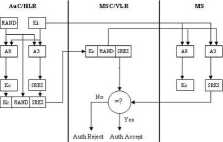5441337391
12
IJCSI International Journal of Computer Science Issues, Vol. 7, Issue 3, No 9, May 2010 www.IJCSI.org
3.1 Subscribers Identity Authentication
As mentioned above, the SIM card holds IMS1, phone number, authentication key Ki, subscriber-relevant data and security algorithms like authentication algorithm (A3). The HLR also Stores a copy of Ki and IMSI etc.
In GSM, the users are first identified and authenticated then the services are granted. The GSM authentication protocol consists of a challenge-response mechanism. The authentication is based on a secret key Ki which is shared between HLR and MS. After a visited MS gets a free channel by requesting BS, it makes a reąuest for its location update to MSC through BSC. The MSC, in response, asks MS for its authentication.
In the entire authentication process, the three main actors are the MS, MSC/VLR and HLR/AuC as given in Figurę 2. The mobile station sends its Temporary Mobile Subscriber Identity (TMSI) to VLR in its request for authentication. The MS uses its real identity IMSI when it is switched on for the first time but the temporary identity TMSI is used later. The TMSI is used to provide anonymity to the user identity. After getting the IMSI of the mobile station from the old VLR using TMSI, the VLR sends IMSI to the corresponding HLR/AuC. The HLR/AuC uses authentication algorithm (A3) and ciphering key generation algorithm (A8) to create the encryption key (Kc) and Signed RESuIt (SRES) respectively.

Fiaure 2. The GSM authenlication architecture
The HLR sends the triplet including Kc, RAND and SRES to VLR. The VLR sends the RAND challenge to MS and ask to generate an SRES and send it back. The mobile station creates an encryption key Kc and SRES using algorithms A3 and A8 with the inputs secret key Ki and RAND challenge. It Stores Kc to use it for encryption and sends SRES back to the VLR. The VLR compares SRES with the one sent by HLR. If they match, the authentication succeeds otherwise it fails [1,4,5].
3.2 User Data and Signaling Protection
The encryption key Kc is used by both of the parties (home system and mobile station) to encrypt the data and signaling information using A5 algorithm. The encryption is done by mobile equipment not the SIM because SIM does not have enough power and processing capacity [1, 4,5],
4. Authentication and Ciphering in UMTS
The UMTS, in fact, is the result of evolution in GSM network through GPRS. The GSM networks are capable of voice communication using Circuit Switched (CS) technique while GPRS adds Pocket Switched (PS) technique through the use of some extra nodes like Serving GPRS Support Node (SGSN) and Gateway GPRS Support Node (GGSN). The UMTS, incorporating GPRS nodes and UMTS Terrestrial Radio Access Network (UTRAN), provides both Circuit switched and packet switched services with enhanced multimedia applications.
As stated in 3GPP specification [7], the Circuit switched services are provided by VLR and the packet switched services are provided by SGSN. The UMTS, like GSM/GPRS, uses the concept of Authentication Vector (AV) but unlike GSM/GPRS, the AV comprises of five components: the random challenge (RAND), the expected response (XRES), key for encryption (CK), integrity key (IK) and the authentication token (AUTN). The VLR/SGSN requests HLR/AuC for authentication. The HLR/AuC computes the AV and is sent back as a response to VLR/SGSN without any encryption applied to it. After the authentication is completed, the cipher key CK is used to encrypt the user data and signaling information. Similarly, to preserve the integrity of the important control signals, integrity key (IK) is used.
The GSM Consortium actually provided security to GSM systems relying on security through obscurity where they believed that the algorithms used in GSM would be very hard to break if they were kept secret. Therefore, the GSM specifications and protocols were kept secret away from public to be studied and analyzed by scientific community.
Wyszukiwarka
Podobne podstrony:
14 IJCSI International Journal of Computer Science Issues, Vol. 7, Issue 3, No 9, May 2010 www.IJCSI
15 IJCSI International Journal of Computer Science Issues, Vol. 7, Issue 3, No 9, May 2010 www.IJCSI
IJCSI International Journal of Computer Science Issues, Vol. 7, Issue 3, No 9, May 2010
IJCSI International Journal of Computer Science Issues, Vol. 7, Issue 3, No 9, May 2010
International Journal of Computer Science & Engineenng Survey (UCSES) Vol.6, No.2, Apnl 2015Secu
International Journal of Computer Science & Engineenng Survey (UCSES) Vol.6, No.2, April 2015 Th
International Journal of Computer Science & Engineenng Survey (UCSES) Vol.6, No.2, April 2015 co
International Journal of Computer Science & Engineenng Survey (UCSES) Vol.6, No.2, April 2015 Th
International Journal of Computer Science & Engmeenng Survey (UCSES) Vol.6, No.2, April 2015 sev
International Journal of Computer Science & Engmeenng Survey (IJCSES) Vol.6, No.2, April 2015 4.
International Journal of Computer Science & Engmeenng Survey (IJCSES) Vol.6, No.2, April 2015 4.
International Journal of Computer Science & Engmeenng Survey (UCSES) Vol.6, No.2, April 2015 Fig
International Journal of Computer Science & Engmeenng Survey (UCSES) Vol.6, No.2, April 20157.
International Journal of Computer Science & Engineenng Survey (UCSES) Vol.6, No.2, April
International Journal of Computer Science & Engineenng Survey (UCSES) Vol.6, No.2, April 2015 1.
International Journal of Computer Science & Engineenng Survey (UCSES) Vol.6, No.2, April 2015 Fo
International Journal of Computer Science & Engmeenng Survey (UCSES) Vol.6, No.2, April 2015 2.2
International Journal of Computer Science & Engmeenng Survey (IJCSES) Vol.6, No.2, April 2015 2.
International Journal of Computer Science & Engmeenng Survey (IJCSES) Vol.6, No.2, April 2015 GS
więcej podobnych podstron